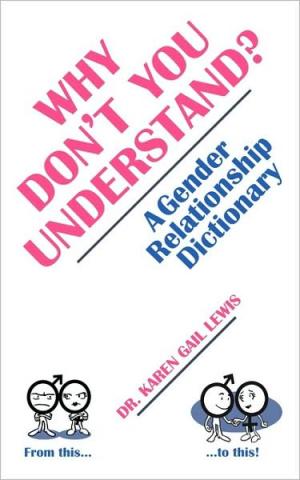Why Don’t You Understand?: A Gender Relationship Dictionary

Is it just me, or should a person with designation “Dr.” in front of her name know the difference between sex and gender? True: language changes all the time and words gain new meanings. So, as American society becomes increasingly uptight when talking about sex (the act), sex (the anatomical distinction) has been replaced in our vernacular with a word that refers to the classic assumptions for social role play placed upon each sex: gender. (It would seem we’re the new Victorians.)
This ambiguity isn’t the only issue I have with Dr. Karen Gail Lewis’ Why Don’t You Understand?. While the good doctor (of education) assumes that women are generally oversensitive, spontaneously emotional, nagging crackpots and men are under-responsive, clueless dingbats, and in doing so assumes too much; her real crime is in assuming that heterosexual couples are made up of these two parts universally. The answer to your query, Doc, isn’t that men and women don’t understand each other sometimes because we are different from each other owing to our sexes, but that people in general are unique individuals and, therefore, different from each other irrespective of their sexes.
It is the case that this dictionary comes along twenty or so years too late, now that we’ve been liberated from gender in many ways. Not all men have trouble expressing their feelings because they live in fear of a beating from dad or name-calling from school bullies. Yet Lewis has the audacity to make blanket observations like: “Men do not confront a relationship problem unless absolutely necessary because – like the boy who took apart and re-assembled a clock, only to have one piece left over – the risk is that they’ll make things much worse.”
Do men in homosexual relationships both behave this same way? If so, how do their problems get solved? What about women who don’t confront relationship problems head on? Are they abnormal? This text prompts many questions like these.
Education is never a waste. It’s a great idea to recognize your, and your partner’s, patterns of behavior. This can help you avoid many of the miscommunications detailed in this book. But the problem with gender assumptions is that they limit us. You can believe in astrology, for instance, but that doesn’t mean that you believe all people born under the sign of Aquarius are friendly yet unpredictable, at least not in the same exact way as the next Aquarian.
Of course, Lewis could have avoided this overwhelming analytic pitfall by eliminating the language of assumption. She could have described scenarios between Individual A and Individual B rather than Category Man and Category Woman. She could have contributed to the emerging relevance of queer theory, which challenges sex and gender binaries and their resulting “normal” behaviors. It is the acceptance of gender fluidity that liberates men and women by allowing us each to be the kind of person it feels good to be.
Wow, great review. This books sounds very unfortunate...you think a publisher or editor would have seen some problems.
Sounds like a flawed book! I wonder, though...what do you mean by "new Victorians"?
"New Victorians" The Victorian era refers to a cultural shift, not just in England where it got its namesake, but wherever English rule stretched: to colonies and communities across the globe. Before this sweep of new propriety, sexuality was more openly discussed. It was not uncommon for people to kiss or hold hands or flirt in public; even games of "Leap Frog" were known to occur, between consenting adults. The spread of veneral disease among other things led to a tightening of morals in English society during the mid-1800's. Thus, we come to think of the Victorians as prudish. It is also rather prudish, is it not, to fear using the word "sex" in public because we're uncomfortable drawing attention to intercourse?